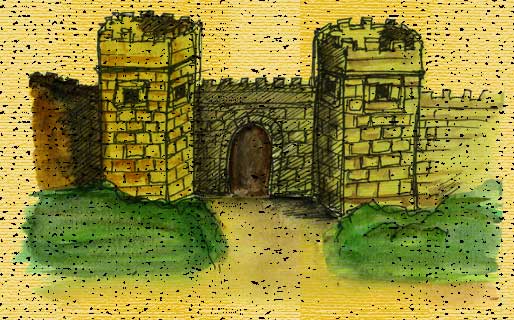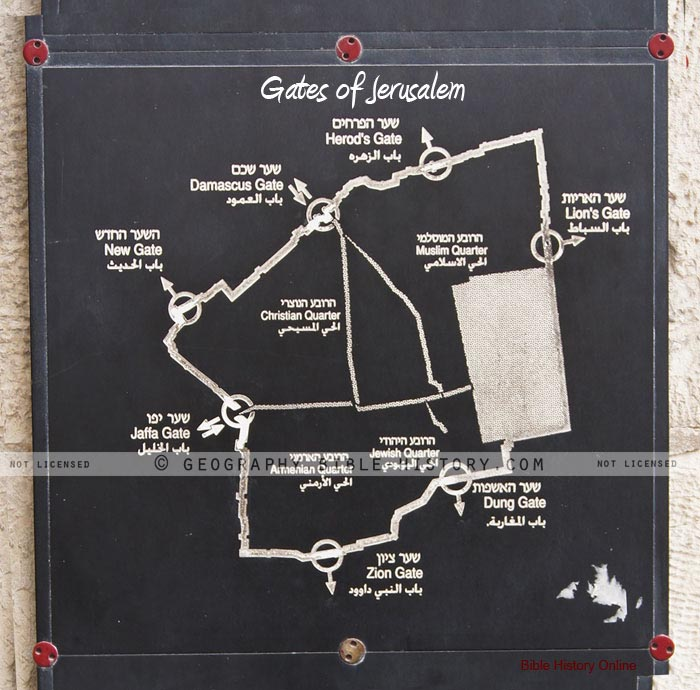The Damascus Gate - First Century Jerusalem

Modern Image of the Damascus Gate in jerusalem
![]()
 Damascus
Gate is the main entrance to the Old City of Jerusalem. It is located in the
wall on the city's northwest side where the highway leads out to Nablus, and
from there, in times past, to the capital of Syria, Damascus; as such, its
modern English name is Damascus Gate, and its modern Hebrew name, Sha'ar Shkhem
(Hebrew: שער שכם), meaning Shechem Gate, or Nablus Gate. Of its Arabic names,
Bab al-Nasr means "gate of victory," and Bab al-Amud (Arabic: باب العامود)
means "gate of the column." The latter name, in use continuously since at least
as early as the 10th century, preserves the memory of a design detail dating to
the 2nd century AD Roman era gate. - Wikipedia
Damascus
Gate is the main entrance to the Old City of Jerusalem. It is located in the
wall on the city's northwest side where the highway leads out to Nablus, and
from there, in times past, to the capital of Syria, Damascus; as such, its
modern English name is Damascus Gate, and its modern Hebrew name, Sha'ar Shkhem
(Hebrew: שער שכם), meaning Shechem Gate, or Nablus Gate. Of its Arabic names,
Bab al-Nasr means "gate of victory," and Bab al-Amud (Arabic: باب العامود)
means "gate of the column." The latter name, in use continuously since at least
as early as the 10th century, preserves the memory of a design detail dating to
the 2nd century AD Roman era gate. - Wikipedia
History
In its current form, the gate was built in 1537
under the rule of Suleiman the Magnificent, the Sultan of the Ottoman Empire.[1]
Underneath, remains of a gate dating to the time of the Roman rule of Hadrian in
the 2nd century AD have been discovered and excavated.[1] In front of this gate
stood a Roman victory column topped with the Emperor Hadrian's image, as
depicted on the 6th century Madaba Map.[1] This historical detail is preserved
in gate's Arabic name, Bab el-Amud, meaning "gate of the column".[1] On the
lintel to the 2nd century gate, under which one can pass today, is inscribed the
city's name under Roman rule, Aelia Capitolina.[1] Hadrian had significantly
expanded the gate which served as the main entrance to the city from at least as
early as the 1st century BC during the rule of Agrippa.[4]
One of eight gates remade in the 10th century, Damascus Gate is the only one to
have preserved the same name (i.e. Bab al-Amud) in modern times.[3] The
Crusaders called it St. Stephen's Gate (in Latin, Porta Sancti Stephani),
highlighting its proximity to St. Stephen's Church and the site of his
martyrdom.[2] Several phases of construction work on the gate took place the
early Ayyubid period (1183-1192) and both early 12th century and later 13th
century Crusader rule over Jerusalem.[2] A 1523 account of a visit to Jerusalem
by a Jewish traveller from Leghorn uses the name B�b el 'Amud and notes its
proximity to the Cave of Zedekiah.[5] - Wikipedia
Description
Damascus Gate is flanked by two towers, each equipped with machicolations. It is located at the edge of the Arab bazaar and marketplace. In contrast to the Jaffa Gate, where stairs rise towards the gate, in the Damascus Gate, the stairs descend towards the gate. Until 1967, a crenellated turret loomed over the gate, but it was damaged in the fighting that took place in and around the Old City during the Six-Day War. In August 2011, Israel restored the turret, including its arrowslit, with the help of pictures from the early twentieth century when the British Empire controlled Jerusalem. Eleven anchors fasten the restored turret to the wall, and four stone slabs combine to form the crenellated top.[6] - Wikipedia

Painted sketch of the Damascus gate
The Seven Gates of Jerusalem

Photo taken from the Ramparts Walk from the Jaffa Gate to the Lion's Gate in
Jerusalem
Many gates were located in first century
Jerusalem and here are a few: The Dung Gate was part of the southern wall near
the city of David leading to the Hinnom Valley. There was also the Tekoa Gate
which led a traveler in the direction of Tekoa. The Essene Gate was located in
the southwestern corner and it led into the area of the Essene Quarter. Of the
Joppa Gate was definitely the busiest gate and it led a traveler toward Joppa.
The three mighty towers stood near the Joppa Gate. The Damascus Gate or more
properly the Shechem Gate was very beautiful located along the second wall. The
Eastern Gate (Susa Gate) was located on the eastern wall leading into the Kidron
Valley and the Mount of Olives.
![]()
Read The Bible
- 1599 Geneva Bible (GNV)
- 21st Century King James Version (KJ21)
- American Standard Version (ASV)
- Amplified Bible (AMP)
- Amplified Bible, Classic Edition (AMPC)
- Authorized (King James) Version (AKJV)
- BRG Bible (BRG)
- Christian Standard Bible (CSB)
- Common English Bible (CEB)
- Complete Jewish Bible (CJB)
- Contemporary English Version (CEV)
- Darby Translation (DARBY)
- Disciples’ Literal New Testament (DLNT)
- Douay-Rheims 1899 American Edition (DRA)
- Easy-to-Read Version (ERV)
- English Standard Version (ESV)
- English Standard Version Anglicised (ESVUK)
- Evangelical Heritage Version (EHV)
- Expanded Bible (EXB)
- GOD’S WORD Translation (GW)
- Good News Translation (GNT)
- Holman Christian Standard Bible (HCSB)
- International Children’s Bible (ICB)
- International Standard Version (ISV)
- J.B. Phillips New Testament (PHILLIPS)
- Jubilee Bible 2000 (JUB)
- King James Version (KJV)
- Lexham English Bible (LEB)
- Living Bible (TLB)
- Modern English Version (MEV)
- Mounce Reverse Interlinear New Testament (MOUNCE)
- Names of God Bible (NOG)
- New American Bible (Revised Edition) (NABRE)
- New American Standard Bible (NASB)
- New American Standard Bible 1995 (NASB1995)
- New Catholic Bible (NCB)
- New Century Version (NCV)
- New English Translation (NET)
- New International Reader's Version (NIRV)
- New International Version - UK (NIVUK)
- New International Version (NIV)
- New King James Version (NKJV)
- New Life Version (NLV)
- New Living Translation (NLT)
- New Matthew Bible (NMB)
- New Revised Standard Version (NRSV)
- New Revised Standard Version Catholic Edition (NRSVCE)
- New Revised Standard Version, Anglicised (NRSVA)
- New Revised Standard Version, Anglicised Catholic Edition (NRSVACE)
- New Testament for Everyone (NTE)
- Orthodox Jewish Bible (OJB)
- Revised Geneva Translation (RGT)
- Revised Standard Version (RSV)
- Revised Standard Version Catholic Edition (RSVCE)
- The Message (MSG)
- The Voice (VOICE)
- Tree of Life Version (TLV)
- World English Bible (WEB)
- Worldwide English (New Testament) (WE)
- Wycliffe Bible (WYC)
- Young's Literal Translation (YLT)
Table of Contents
Main Menu
- Ancient Assyrian Social Structure
- Ancient Babylonia
- Ancient Canaan During the Time of Joshua
- Ancient History Timeline
- Ancient Oil Lamps
- Antonia Fortress
- Archaeology of Ancient Assyria
- Assyria and Bible Prophecy
- Augustus Caesar
- Background Bible Study
- Bible
- Biblical Geography
- Fallen Empires - Archaeological Discoveries and the Bible
- First Century Jerusalem
- Glossary of Latin Words
- Herod Agrippa I
- Herod Antipas
- Herod the Great
- Herod's Temple
- High Priest's in New Testament Times
- Jewish Literature in New Testament Times
- Library collection
- Map of David's Kingdom
- Map of the Divided Kingdom - Israel and Judah
- Map of the Ministry of Jesus
- Matthew Henry Bible Commentary
- Messianic Prophecy
- Nero Caesar Emperor
- Online Bible Maps
- Paul's First Missionary Journey
- Paul's Second Missionary Journey
- Paul's Third Missionary Journey
- Pontius Pilate
- Questions About the Ancient World
- Tabernacle of Ancient Israel
- Tax Collectors in New Testament Times
- The Babylonian Captivity
- The Black Obelisk of Shalmaneser
- The Books of the New Testament
- The Court of the Gentiles
- The Court of the Women in the Temple
- The Destruction of Israel
- The Fall of Judah with Map
- The History Of Rome
- The Incredible Bible
- The Jewish Calendar in Ancient Hebrew History
- The Life of Jesus in Chronological Order
- The Life of Jesus in Harmony
- The Names of God
- The New Testament
- The Old Testament
- The Passion of the Christ
- The Pharisees
- The Sacred Year of Israel in New Testament Times
- The Samaritans
- The Scribes
Ancient Questions
- Why Do the Huldah Gates Appear Different in Ancient Replicas and Modern Photos?
- What Is the Origin of the Japanese and Chinese Peoples? A Biblical Perspective
- How did the ancient Greeks and Romans practice medicine and treat illnesses?
- What were the major contributions of ancient Babylon to mathematics and astronomy?
- How did the ancient Persians create and administer their vast empire?
- What were the cultural and artistic achievements of ancient India, particularly during the Gupta Empire?
- How did ancient civilizations like the Incas and Aztecs build their remarkable cities and structures?
- What were the major trade routes and trading practices of the ancient world?
- What was the role of slavery in ancient societies like Rome and Greece?
- How did the ancient Mayans develop their sophisticated calendar system?
Bible Study Questions
- Why Do Christians Celebrate Christmas?
- How Many Chapters Are There in the Bible?
- The Five Key Visions in the New Testament
- The 400-Year Prophecy: Unpacking Genesis 15 and the Journey of a People
- The Authorized (King James) Version (AKJV): Historical Significance, Translation Methodology, and Lasting Impact
- Exploring the English Standard Version (ESV): Its Aspects, Comparisons, Impact on Biblical Studies, and Church Use
- A Detailed Historical Analysis of Language Updates in the KJ21: Comparison with Other Versions
- A Detailed Historical Analysis of the American Standard Version (ASV): Comparison to the King James Version, Influence on Later Translations, and Evaluation of Strengths and Weaknesses
- A Detailed Historical Analysis of Amplifications in the Amplified Bible (AMP) and Its Comparison to Other Bible Translations
- Detailed Historical Analysis of the Amplified Bible Classic Edition (AMPC): Examples of Amplifications and Comparative Analysis with Other Bible Translations
About
Welcome to Free Bible: Unearthing the Past, Illuminating the Present! Step into a world where ancient history and biblical narratives intertwine, inviting you to explore the rich tapestry of human civilization.
Discover the captivating stories of forgotten empires, delve into the customs and cultures of our ancestors, and witness the remarkable findings unearthed by dedicated archaeologists.
Immerse yourself in a treasure trove of knowledge, where the past comes alive and illuminates our understanding of the present.
Join us on this extraordinary journey through time, where curiosity is rewarded and ancient mysteries await your exploration.
Recent posts
-

How to Choose the Perfect Christian Living Community
Did you know that two-thirds of Americans identify as Christians and more than half of those attend religious services more than once a month? When se... -

How to Build a Modern Slot Machine Engine: Math Models and RTP Design
Introduction: The Heart of Modern Slots Slot machines have evolved tremendously since the first mechanical reels appeared in the 1890s. Digital techno... -

Why Discipleship Ministries Matter: How They Shape Churches and Communities
Discipleship ministries have traditionally played an important role in Christians' spiritual growth and the long-term viability of their churches. Chr... -

A Historical Journey of Health Insurance: From Ancient Mutual Aid to Modern Coverage
The modern form of health insurance, which is premium based, pooled risk financial coverage during illness is a relatively new development. But the th... -

Get a Crypto License in Poland - Secure, EU-Ready, and Backed by Prifinance Expertise
Expand your crypto business legally in the European Union with a crypto license in Poland under the MiCA framework. Poland has become one of the most ...